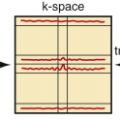Technical Aspects
Contrast agents enhance the visualization of vascular structures as well as pathologic tissues, which appear more prominent against the background of normal tissue. Development of novel contrast agents continues to be an exciting area, with new targeted agents, blood pool agents, and agents based on nanoparticle technologies. This discussion is focused on water-soluble gadolinium chelates used in abdominal and pelvic magnetic resonance imaging (MRI).
Principle of Relaxivity
The current use of gadolinium is based on paramagnetism. Gadolinium has more orbitals than electron pairs, an odd number, resulting in a net electron spin, and is therefore classified as paramagnetic. Its magnetic moment in addition with unpaired electrons makes gadolinium a useful compound for MRI. Although any agent that alters the local magnetic field can alter both T1 and T2 relaxation, gadolinium predominantly shortens T1 relaxation.
Chemical Structure of Currently Approved Chelates of Gadolinium
Gadolinium–diethylenetriamine pentaacetic acid (Gd-DTPA; gadopentetate) was first approved in 1988. Box 10-1 summarizes the currently approved agents for use in Europe and the United States. All of these agents contain a gadolinium ion centrally, an octadentate ligand, and a coordinated water molecule in their chemical structure. The octadentate ligand is responsible primarily for safety because it provides thermodynamic stability. Unchelated gadolinium is severely toxic to human tissues and cells. The coordinated water molecule allows for rapid chemical exchange with other water molecules in the solution that gadolinium is in, resulting in shortening of relaxation time of the water environment.
- •
Gd-DTPA (Magnevist)
- •
Gd-DO3A-butrol (Gadovist)
- •
Gd-DOTA (Dotarem)
- •
Gd-DTPA-BMA (Omniscan)
- •
Gd-DTPA-BMEA (OptiMARK)
- •
Gd-HPDO3A (ProHance)
- •
Gd-EOB-DTPA (Primovist / Eovist)
- •
GD-BOPTA (MultiHance)
Biodistribution
The human body can be divided into extracellular and intracellular compartments. Currently approved gadolinium chelates are extracellular space agents. The extracellular compartment can be simplified into the intravascular and interstitial spaces, which then are linked to the kidneys and liver, where there is hepatobiliary or renal excretion. Agents are initially distributed within the intravascular space and then diffuse into the interstitial space. As an extracellular agent, gadolinium chelates are very hydrophilic and thereby shorten the T1 relaxation time of the molecules around them. Although gadolinium chelates are nonspecific and their distribution is governed by perfusion, tissues that have a larger extracellular or interstitial space, increased capillary breakdown, or increased permeability will also receive a higher concentration of contrast agent, thereby appearing brighter on T1-weighted sequences.
Phases of Vascular and Tissue Enhancement
As soon as gadolinium is injected intravenously, the agent is distributed into the pulmonary circulation, aorta, systemic arteries, capillaries, interstitial space, and kidneys for excretion into the urinary collecting system. The phases of enhancement in the vessels and tissues can be divided into arterial, blood pool, and extracellular phases.
The arterial phase is best imaged using fast pulse sequences that allow for capturing the initial arrival of contrast agent into arteries before venous filling. Temporal resolution maximization is critical for good arterial phase imaging. Arterial phase imaging is useful for evaluating arteries and arterially enhancing lesions within the liver or pancreas. Faster techniques such as those using parallel imaging techniques have enabled better quality arterial phase imaging. The best time for arterial phase imaging usually occurs at 20 to 40 seconds after injection.
The blood pool phase, or portal venous phase, follows 60 to 80 seconds after injection and is characterized by contrast agent distributed throughout the vessels. Tumors within the abdomen and pelvis are commonly more prominent during this phase. This is also the phase of highest liver parenchymal enhancement. In many cases, malignancies may be less intense in the portal venous phase. As a result, the portal venous phase is an important component for any evaluation of liver neoplasms.
The extracellular phase follows 120 to 150 seconds after intravenous injection. During this phase, the contrast agent begins to diffuse into the interstitial component of the extracellular space, and pathologic processes such as increased interstitial space or abnormal capillary structure with increased permeability are reflected. It is also during this phase that the contrast agent begins to undergo filtration in the kidneys and accumulates in the collecting system and bladder.
The hepatocyte phase follows 10 to 20 minutes after injection of gadoxetic acid, or 40 to 120 minutes after injection of gadobenate dimeglumine benzyloxy-propionic tetraacetic acid. After injection, these agents have an initial intravascular phase similar to that of other gadolinium chelates, but they accumulate in the hepatocytes of the liver parenchyma during the later phase. Thus, the lesion-to-liver contrast is increased and these agents aid in the detection of small liver lesions.
Stay updated, free articles. Join our Telegram channel

Full access? Get Clinical Tree








